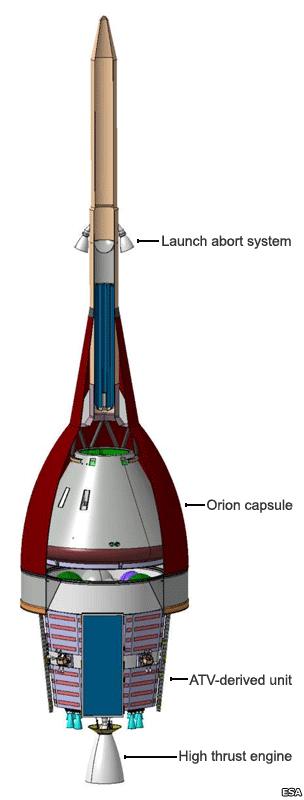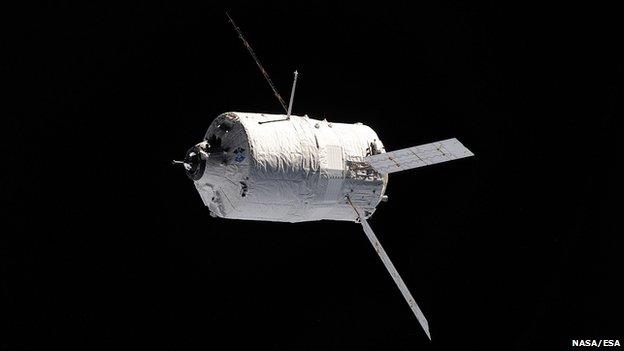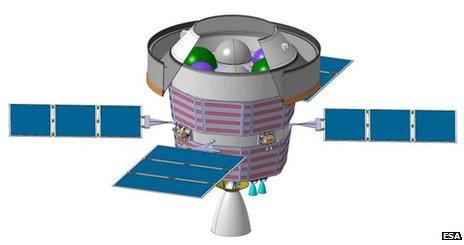European tech could propel Nasa's Orion capsule
- Published

Europe is looking to play a significant role in America's plans for the manned exploration of deep space.
Nasa has detailed its vision for a huge new rocket system that could send astronauts to asteroids and even Mars.
European engineers believe they could contribute to this project by providing the propulsion unit that pushes the rocket's capsule to these locations.
Participation would require the agreement of European member states and a budget to fund the development work.
A formal proposal is likely to be presented for consideration by the bloc's space ministers when they meet next year in Italy.
One attraction is that it would almost certainly lead eventually to European astronauts being invited to take part in deep space missions.
If the project is approved, engineers would hope to have the propulsion unit, or service module, ready to fly on the American rocket's first test flight.
"The first launch is planned in 2017, and if we can get all the preparatory work done in time for getting a decision at the upcoming ministerial conference - we will be able to provide our share to the maiden flight. The development time would be tight, but possible," said Thomas Reiter, the director of human spaceflight at the European Space Agency (Esa).
Nasa's new Space Launch System (SLS) is a multi-billion-dollar venture to take humans beyond the International Space Station (ISS) and the confines of low-Earth orbit.
It calls for a rocket that is taller and more powerful even than the boosters that took man to the Moon in the 1960s and 70s.
Atop this vehicle would sit a capsule, called Orion, equipped with the life support technologies able to sustain humans on long-duration missions.
But this capsule will need a propulsion unit to guide its path across space.
Esa engineers, in discussion with their US counterparts, have proposed they take responsibility for this unit.
Its design would lean heavily on technologies already developed for the Automated Transfer Vehicle (ATV).
This is Europe's robotic freighter, which is flown regularly to the ISS to keep it stocked up with fuel, air, water, food and spare parts.
The ATV is also used to drive the 400-tonne orbital complex higher into the sky to stop it falling back to Earth.

The Automated Transfer Vehicle is the means by which Europe pays its way on the ISS
In the technical discussions between Nasa and Esa, the concept now being proposed is to take the service module from the ATV, upgrade it and give to Orion.
ATV's service module includes its thrusters, electrics, parallel computers, communications equipment and most of its avionics.
All these elements would need to be taken to a new standard, including the incorporation of a high-thrust engine and a guidance, navigation and control (GNC) system suitable for deep space operation.
At the moment, the ATV is being produced under a barter arrangement, whereby its contribution to the ISS project essentially covers the costs at the platform that Europe would otherwise have to fund in cash.
This arrangement will see three further ATVs fly to the station and takes in the period up to about 2016/17.
Thereafter, Europe's participation in the SLS and Orion might be seen as its contribution to the common operating costs of the ISS.
But for this concept to be taken any further, European ministers will need to approve a budget at their high-level council in 2012.
The budget would be on the order of several hundred million euros.
Ministers would also want to be convinced that the development offered something additional to European capability in space - a capability that could be deployed in other types of activity.
"So now we are looking into developing this ATV derivative as a service module for Orion but also making the first steps in advancing certain systems in the areas of propulsion and GNC; and those systems could be used eventually in a big European space tug that could remove old satellites or debris from orbit, for example," Dr Reiter told BBC News.

The ATV-derived Orion service module could form the basis of a future European space tug to service or de-orbit faulty satellites
- Published14 September 2011
- Published22 June 2011
- Published25 May 2011
- Published5 May 2011
- Published11 October 2010
- Published8 July 2011